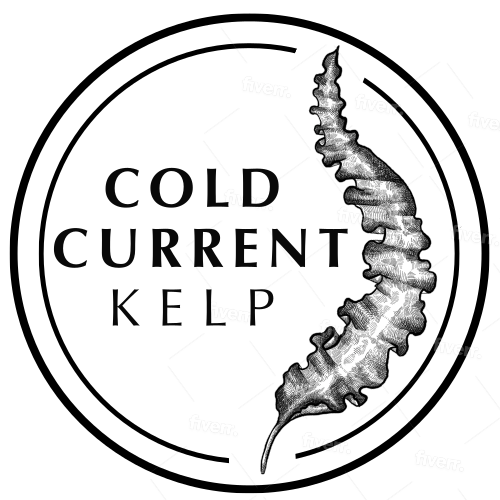From Sea Farm to Skin
 Life on our Southern Maine kelp farm begins in early winter. A line suspended at the ocean’s surface cultivates tiny sugar kelp blades throughout the harsh winter months. Early spring sees an explosion of growth, as sugar kelp can grow 1/2 inch to 2 inches per day.
Life on our Southern Maine kelp farm begins in early winter. A line suspended at the ocean’s surface cultivates tiny sugar kelp blades throughout the harsh winter months. Early spring sees an explosion of growth, as sugar kelp can grow 1/2 inch to 2 inches per day.
 By the time we harvest in the spring, the kelp has grown into long, ruffled blades reaching up to 10 feet in length. We harvest our kelp by hand, cutting it off the line and placing it into totes. Once harvested, we load the kelp onto a truck and transport it to a nearby greenhouse.
By the time we harvest in the spring, the kelp has grown into long, ruffled blades reaching up to 10 feet in length. We harvest our kelp by hand, cutting it off the line and placing it into totes. Once harvested, we load the kelp onto a truck and transport it to a nearby greenhouse.
 In the greenhouse, we hang the kelp on lines to sustainably stabilize and preserve its bioactive compounds. As it dries, sugar kelp changes from a beautiful deep brown to a vibrant green while losing about 90% of its weight. This transformation takes place within 24 hours if the weather is warm and dry.
In the greenhouse, we hang the kelp on lines to sustainably stabilize and preserve its bioactive compounds. As it dries, sugar kelp changes from a beautiful deep brown to a vibrant green while losing about 90% of its weight. This transformation takes place within 24 hours if the weather is warm and dry.
Sugar kelp has become popular among food enthusiasts for its umami taste, dense concentration of nutrients including vitamin B12, iodine, and calcium, as well as its anti-inflammatory compounds and antioxidants. Although known for its salty, briny flavor, the name “sugar kelp” originates from the sweet-tasting white powder that forms on the fronds once dried.
Although known for its salty, briny flavor, the name “sugar kelp” originates from the sweet-tasting white powder that forms on the fronds once dried.
At Cold Current Kelp, our skincare products are proudly handcrafted in Maine, just miles from our kelp farm. Unlike many beauty and skincare brands that rely on imported, untraceable seaweed, we use clean, locally grown, sustainably dried kelp from our small ocean farm.

 Kelp, aided by its rapid growth rate, absorbs excess carbon dioxide, nitrogen and phosphorous from our oceans. It is estimated that kelp is 20 times more efficient at absorbing carbon dioxide from our atmosphere than terrestrial forests. As a result, at scale, kelp can play a role in reducing the effects of global warming. Read more at Carbonplan.org and Oceans2050.com.
Kelp, aided by its rapid growth rate, absorbs excess carbon dioxide, nitrogen and phosphorous from our oceans. It is estimated that kelp is 20 times more efficient at absorbing carbon dioxide from our atmosphere than terrestrial forests. As a result, at scale, kelp can play a role in reducing the effects of global warming. Read more at Carbonplan.org and Oceans2050.com.









